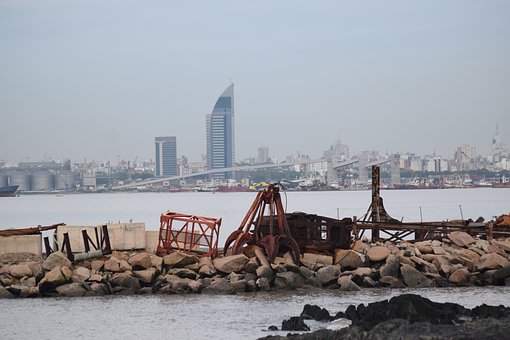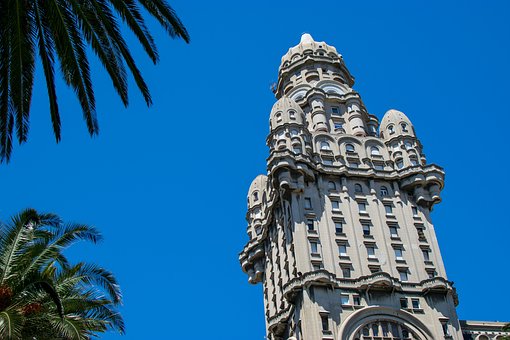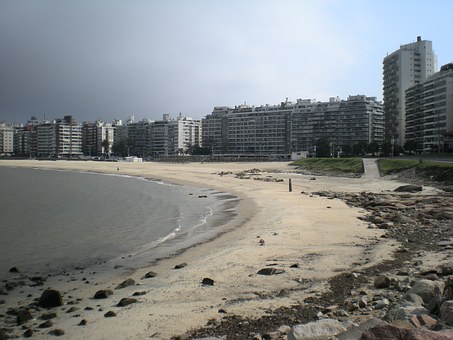4
Hours in Montevideo
Becoming
an Expat in Uruguay
4 Hours in Montevideo - Major
Port and Uruguayan Capital, this City Charms
The Edificio Salvo, Montevideo,
Uruguay, Richard McColl
While Buenos Aires hollers boisterously
across the bay, Montevideo merely whispers confidently. It is this polite
welcome that entices travellers to this enchanting city.
0900-1000
Where better to start the
day than at the beating heart of Montevideo, the Avenida 18 de Julio? Tree-lined
and adorned with banks, shops, cafes, allow yourself to be swept along
by the tides of harassed workers. Before reaching the Plaza de Independencia,
stop by the Gaucho Museum next to the Plaza Fabini. What the museum lacks
in exhibits it makes up for in a brief glimpse into of what must have been.
By the grandeur of the internal organs of this dramatic 19th Century Franco
Italian masterpiece complete with original plasterings, woodwork and ceilings
one gets an idea of colonial Montevideo.

1000-1030
A few blocks beyond in the
Plaza de Independencia with its imposing statue and mausoleum of the father
of Uruguayan independence, Jose Artigas, gaze at the folly that comes in
the shape of the Edificio Salvo, both once a hotel and South America’s
tallest building, it now represents a fading decadence and has been split
into private residences.
1030-1200
Catch a taxi from the Plaza
de Independencia and head East up past the Centenario Stadium, home to
Uruguay’s proud history as a founding father of the Latin American style
of football, don’t stop and keep going to the Cerro at the far western
end of Montevideo.

At 139m high this is no immense
peak to scale. It is however the highest point in the city and the place
from which the City gets its name. From here you can make out old the old
town, the port, the new residential districts and the bustling downtown
hub. The fortress here has some good information regarding the struggles
for independence and the various factions that were involved in the tug
of war for trade dominance in the region.
1200-1300
Before heading back downtown
and while on this side of the city it would be well worth a trip to the
Blanes Museum to see some of Uruguay’s greatest works of art housed in
yet another astounding 19th century mansion.
1300-1500
A long lunch that extends
late into the afternoon is of course de riguer. Cab it down the rambla
boardwalk that extends along the waterfront of the city, passing the well
preened sandy beaches of Ramirez, La Estacada and Los Pocitos until you
reach the Puerto del Buceo alongside the Uruguay Yacht club. Feast on the
freshly caught and prepared seafood at the friendly and unpretentious El
Italiano restaurant.
1500-1630
A well deserved siesta is
in order after a short stroll along the rambla. Recharge those batteries
in preparation for the long afternoon and evening ahead.
1630-1730
It’s back to the Plaza de
Independencia to take in the magnificence and decaying elegance of the
Ciudad Vieja. The old centre and port area has been home to wealth and
squalor since its conception. Consider that 5 years ago the streets were
plagued by rabid dogs and piles of uncollected refuse, the gentrification
and refurbishment has been astounding.
It’s a short stroll to the
Plaza de la Constitucion, the oldest square in Montevideo and home to the
Cathedral.

1730-1800
Continue past the chic boutiques,
trendy loft conversions and avant-garde galleries along the Sarandi pedestrian
area and downhill along Ituzaingo street for a well earned coffee at the
Café Brasileiro for a taste of the old world. With high wooden paneled
walls, mirrors and comfortable unstuffy atmosphere, the courteous waiters
attend to a clientele who have possibly been frequenting this locale for
the better part of their lives.
1800-2000
Two blocks on is the Plaza
Zabala, so named after the founder of the city. Feed your inner shopaholic
and buy from the painfully hip and original boutiques along the Sarandi.
Check out the Neo Classical Teatro Solis and the arts and crafts stalls
along the way. Be wary of the horse-drawn carts and bichicomes rag and
bow men in this area, they stop for nobody.
2000-2130
Head back to your hotel for
another break and rest period before the long night ahead of you. Have
no fear, you will be returning to the stunning Ciudad Vieja as Montevideo’s
fashionable nightlife happens here.
2130-2300
To dine lightly at the Mercado
del Puerto is in itself an impossibility. Choose a restaurant from an array
of high quality places, devour Uruguayan beef, soak up the live music of
the dueling Gaucho guitarists and feel your stomach wince at the size of
the favoured Uruguayan grill, including cuts of beef, blood sausage, chorizo,
lamb, tripe and peppers.
2300 onwards
Before entering a club, pause
along the side streets to see if a candombe drum group is practicing with
the resonant chico, rapique or bajo drums. They should not be hard to find
as the echoes and vibrations rock the very foundations of the Old Town.
Dinner having settled, hit a local boliche or club to dance the night away
Uruguayan style.
Top
About the author: Richard
McColl www.suite101.com/profile.cfm/ricardo_emp |



